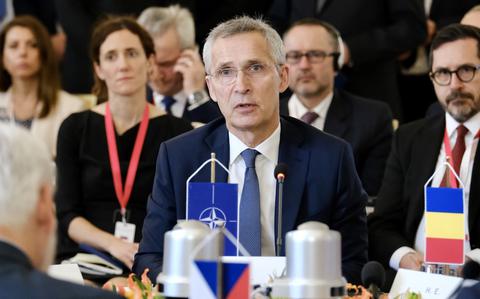Is NATO Meeting Its Defense Spending Targets?

Table of Contents
The 2% GDP Target: A Benchmark Under Scrutiny
The 2% GDP target for defense spending, agreed upon by NATO members in 2014, has become a key benchmark for measuring the alliance's commitment to collective defense. This pledge signifies a commitment to increase military expenditure to at least 2% of each nation's Gross Domestic Product (GDP). The rationale behind this target is straightforward: strengthening collective defense capabilities to deter potential aggression and ensure the alliance's ability to respond effectively to threats.
-
Origin and Significance: The 2% GDP target emerged from concerns about declining defense spending across many NATO allies following the end of the Cold War. It aimed to reverse this trend and ensure a sufficient level of military readiness across the alliance.
-
Current Adherence: While some NATO members, notably the United States and the United Kingdom, consistently exceed the 2% GDP target for military expenditure, many others fall short. Germany, for instance, has faced considerable pressure to increase its defense budget to meet this benchmark. The disparity in adherence highlights the challenges in achieving a unified approach to defense spending within the alliance.
-
Criticisms and Debates: The 2% target has faced considerable criticism. Some argue that it's an insufficient metric, failing to account for the quality and effectiveness of military spending. Others contend that a focus solely on GDP percentage neglects other crucial factors impacting defense capability, such as the specific nature of military modernization programs and personnel costs. The debate continues regarding whether this benchmark adequately reflects the true level of commitment to collective security.
Factors Influencing Defense Spending Decisions
Several factors influence the defense spending decisions of individual NATO members. These are rarely simple calculations based on the 2% GDP target alone.
-
National Budgets and Economic Conditions: Each nation's economic circumstances play a vital role. Countries facing economic downturns or significant budgetary constraints may find it difficult to allocate sufficient funds to defense, even if they support the 2% goal in principle.
-
Domestic Politics and Public Opinion: Domestic political priorities and public sentiment significantly impact defense spending. Public support for military spending can fluctuate based on perceived threats and national security concerns. Political pressures and competing priorities for government funding can also influence the allocation of resources.
-
Security Threats and Geopolitical Landscape: The evolving geopolitical landscape, including perceived threats from various actors, directly impacts defense spending decisions. Increased geopolitical instability often leads to calls for increased military spending and investment in specific capabilities.
-
Factors Beyond GDP: The 2% GDP target is only one element of a wider consideration of military readiness and capability. Modernization programs, personnel costs, and the overall effectiveness of military forces should also be evaluated separately.
Consequences of Inadequate Defense Spending
Inadequate defense spending carries significant consequences for NATO's collective security and effectiveness.
-
Military Readiness and Capabilities: Under-spending can directly affect military readiness and operational capabilities. It may lead to outdated equipment, insufficient training, and reduced personnel levels, undermining the alliance's ability to respond to crises.
-
Collective Security and Deterrence: A lack of sufficient defense investment erodes the alliance's ability to deter potential aggressors. A weakened collective defense posture can embolden adversaries and increase the risk of conflict.
-
Vulnerabilities: Insufficient spending increases the alliance's vulnerability to a range of threats, from conventional military aggression to cyberattacks and hybrid warfare. A lack of adequate investment in defense technology also enhances this vulnerability.
-
NATO Effectiveness and Credibility: Inadequate defense spending compromises the overall effectiveness and credibility of NATO. It sends a negative message to both allies and adversaries about the alliance's commitment to collective security.
Future Outlook and Potential Solutions
The future of NATO defense spending depends on several factors, requiring proactive measures.
-
Projected Spending Trends: While some NATO members are showing an increase in defense investment, others lag behind. Future trends will largely depend on economic conditions, geopolitical developments, and national political will.
-
Improved Burden-Sharing: Reforms aimed at improving burden-sharing within the alliance are essential. This could involve greater cooperation on defense procurement, joint military exercises, and the sharing of capabilities amongst NATO allies.
-
Increased Security Cooperation: Strengthening security cooperation and strategic partnerships with other nations will contribute to shared defense burden and improve overall security.
-
Investing in Modernization: Investing in military modernization and technological advancements is crucial to maintain a technologically advanced military that can tackle modern threats.
Conclusion:
The question of whether NATO is meeting its defense spending targets remains complex. While some members consistently exceed the 2% GDP target, many others fall short, highlighting the challenges in achieving a unified approach to defense spending. The consequences of inadequate investment in defense are significant, potentially undermining the alliance's ability to deter aggression and safeguard its members. Continued monitoring of spending levels, coupled with open dialogue and strategic adjustments regarding NATO defense spending, is vital to ensure the alliance's continued strength and ability to safeguard its members. Further research into NATO defense spending and its implications for collective security is essential. Let's continue the conversation about NATO defense spending and its crucial role in maintaining global stability.

Featured Posts
-
 Wrexham What To Expect On Your Visit
May 28, 2025
Wrexham What To Expect On Your Visit
May 28, 2025 -
 Interest Group Highlights Negative Impact Of Rent Regulation Changes On Tenants
May 28, 2025
Interest Group Highlights Negative Impact Of Rent Regulation Changes On Tenants
May 28, 2025 -
 Liverpool Transfers Assessing Two Potential Wingers Amidst Salah Contract Talks
May 28, 2025
Liverpool Transfers Assessing Two Potential Wingers Amidst Salah Contract Talks
May 28, 2025 -
 Smartphone Samsung Galaxy S25 Ultra 256 Go Vente Flash 5 Etoiles
May 28, 2025
Smartphone Samsung Galaxy S25 Ultra 256 Go Vente Flash 5 Etoiles
May 28, 2025 -
 Padres And Dodgers Extend Winning Streaks Nl West Report
May 28, 2025
Padres And Dodgers Extend Winning Streaks Nl West Report
May 28, 2025
